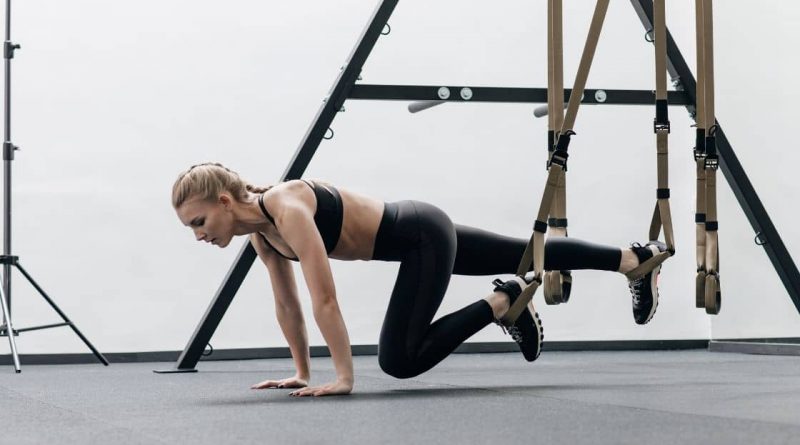The 10 best TRX exercises [+ training plan]
TRX exercises are demanding, but incredibly effective. Because when training with the sling trainer, your entire body is challenged and many muscle groups are trained at the same time.
By the way,
TRX stands for ” Total Body Resistance Exercise ” and describes a simple but innovative training system that challenges the whole body.
The TRX is definitely a fitness studio in your pocket, one of the best fitness equipment for at home and should be part of your home gym. You can completely replace a workout in the gym with the following 10 TRX exercises alone.
The selection of exercises is designed so that you can train the most important muscle groups. I will also show you the gradations of the exercises so that you can benefit from them as a beginning or advanced athlete.
At the end of the article you will find a finished TRX workout.
The 1X1 of the TRX exercises – you should pay attention to this
In order to get the maximum success from the exercises with the TRX, you should pay attention to a few details. I have summarized the most important points for you here:
- Use the setting options : With TRX training you have two setting options: the length of the TRX and your position in relation to the device. These possibilities are already sufficient to vary the level of difficulty.
- Set your goal : Before you start training, you should know what exactly you want to achieve. The so-called ” Time under Tension ” describes how long the muscles are active during an exercise. Different exercise times and intensities ensure different adaptations of your muscles:
- Maximum strength (strength building) | Time: 20 to 40 seconds (3 to 5 repetitions)
- Hypertrophy (muscle growth) | Time: 40 to 60 seconds (6 to 12 repetitions)
- Strength endurance | Time: 60 to 90 seconds (> 15 repetitions)
- Increase yourself from training to training: Progression, i.e. the continuous increase in your training load, is important to achieve sustainable success and avoid stagnation. Try to increase the load a little with each workout. This is very easy to do using the setting options on the TRX.
- Vary your TRX exercises: If you only train with the same exercises and loads, you cannot expect steady progress. In addition to progression, our body also needs regular variation of the TRX exercises. You can vary the exercises, certain starting positions and the load times. You should adjust your training plan every 4 to 6 weeks.
If you want to find out more about sling training, take a look at our extensive article on this topic: Sling trainer – the best tips for effective training
The 10 best TRX exercises
If you already do strength training regularly, then you probably know most of the following exercises. But let yourself be surprised, because these exercises develop a completely new effect on the TRX band.
The instability results in completely different loads on your muscles. A push-up on the floor cannot be compared to a push-up in the TRX.
It is important to first master all exercises without the TRX – because this way you guarantee a safe and effective training, whether outdoors or as a home workout.
If you are a beginner, you will find a good explanation of the TRX basics and the most important basic exercises by Dr. Ingo Froböse:
Now go! Here you can find the 10 most effective TRX exercises:
Pushups
The push-up is one of the most popular and demanding TRX exercises.
Starting position: Take hold of both handles and lean slightly against the TRX so that the belt is under tension. Tense your stomach and buttocks and pull your shoulder blades together.
Execution: Now slowly bend your arms, with the elbows pointing backwards. Only go as deep as you can control the position (at least a right angle in the elbow). Then press yourself back to the starting position.
Variation: The exercise becomes more difficult if you get more horizontal.
Trained muscle groups: Chest muscles, arm extensors
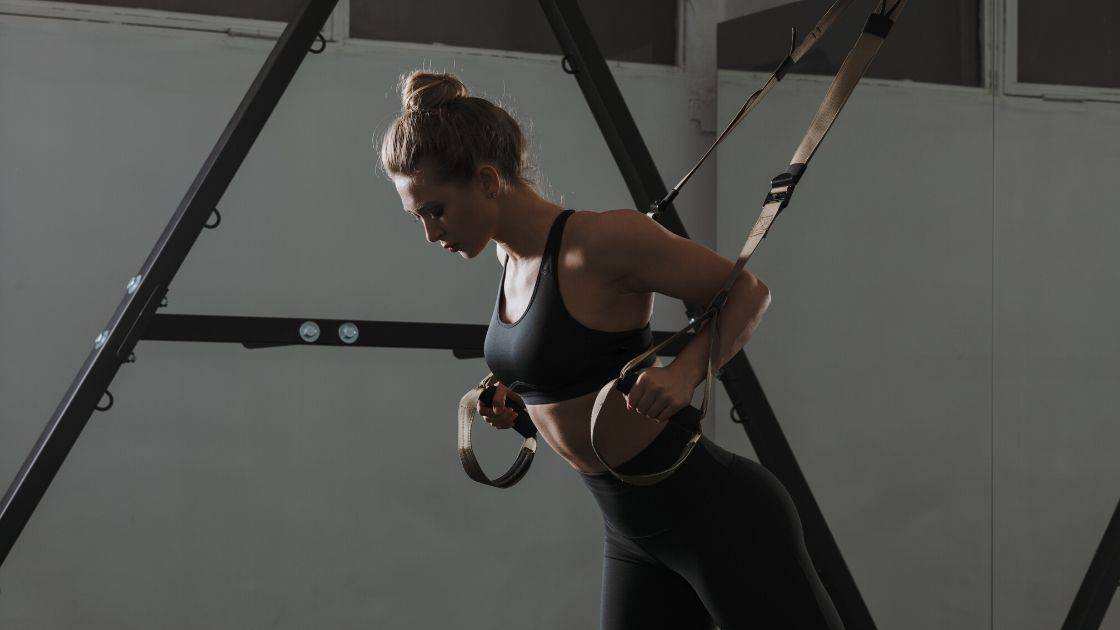
squat
Squats are possible on the TRX. You can use the TRX as an aid to training heavier forms of the squat.
Starting position: Stand up straight and hip width apart, take both handles in your hand and lean back slightly with your body straight to put the goods under tension.
Execution: Slowly bend your knees until your thighs are at least parallel to the floor and then push yourself up again. Use your arms only for stabilization.
Variation: The exercise becomes interesting if you do it with one leg. You can use your arms as support at the beginning. The one-legged squat can be trained very well as a TRX exercise.
Trained muscle groups: Thigh muscles, glutes
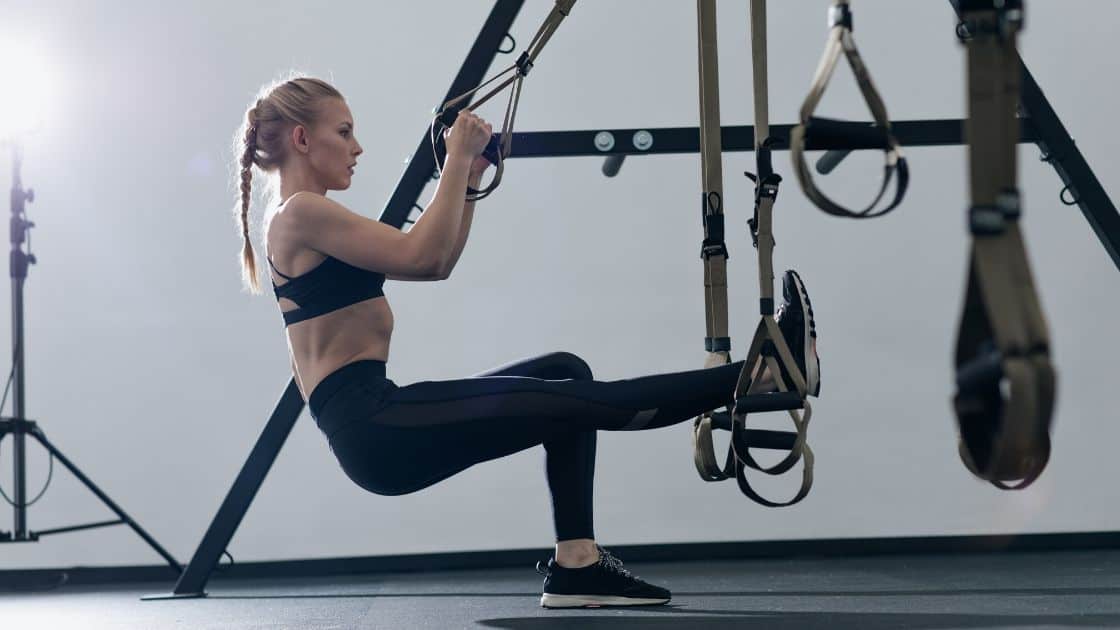
Ruderzug
The advantage of the TRX is that it is a good fitness machine to train the back. The rowing is one of the most suitable TRX exercises for this.
Starting position: Stand up like a squat, but tilt your body a little more. The more your feet wander in the direction of the TRX’s suspension, the more difficult the exercise becomes.
Execution: Start with your arms straight and slowly pull your body towards the handles, about until your chest is next to your hands. Pay attention to maximum body tension. Then slowly lower yourself back to the starting position.
Variation: The more you go horizontally, the more strenuous this TRX exercise becomes. The rowing is particularly intense when your body line is completely parallel to the floor.
Trained muscle groups: back muscles, biceps
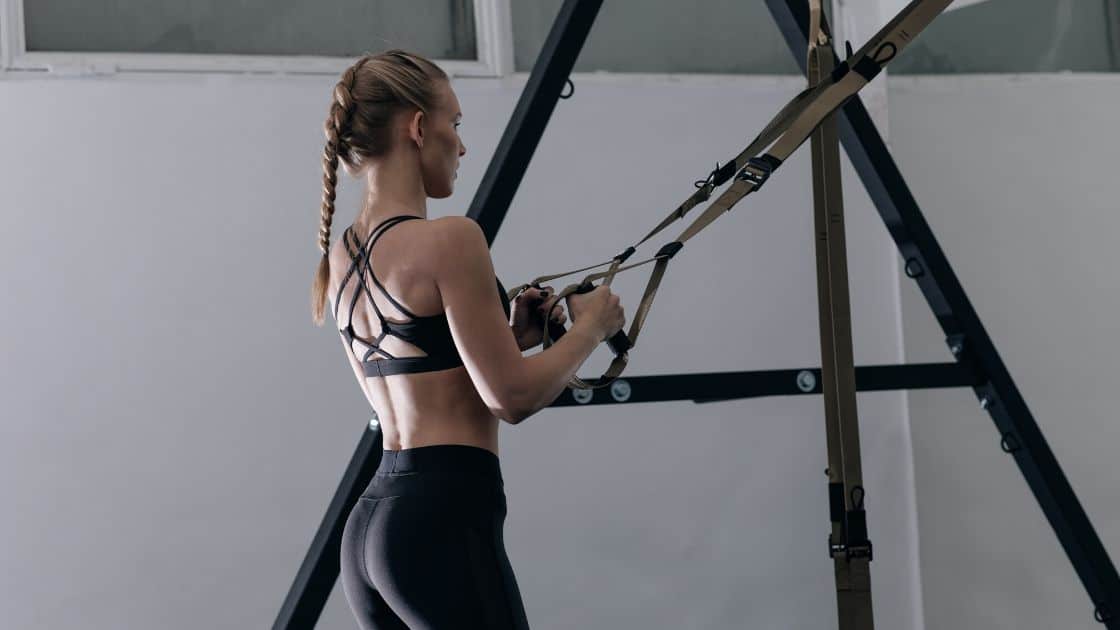
Plank
The plank (front support or forearm support) is a static TRX exercise. It requires good body tension. It can help to train optimal body tension, which affects all other TRX Band exercises.
Starting position: Place your feet in the leg loops of the TRX and make sure that the TRX hangs straight down. Now support yourself on your forearms and make sure that your elbows are directly under your shoulder.
Execution: Now lift your body upwards so that your body line is parallel to the floor. You must now keep this exercise static. Pay particular attention to tension in the buttocks, stomach (!) And the upper back and keep your entire spine straight. It is best to let a partner control you at the beginning.
variation: Alternatively, you can also use your hands or forearms to support the TRX. The feet are then on the ground. You can also lift one leg to make the exercise more difficult.
Trained muscle groups: Abdominal muscles, back muscles, glutes
lunges
The TRX is also great for training lunge. The sling trainer results in a variety of variations.
Starting position: Place one foot in the leg loops (both leg loops for one foot). Take a lunge so that foot is behind you. At the beginning you can use a chair or stick as a stabilization aid.
Execution: Now bend your front leg in analogy to a knee flexion movement until the thigh is parallel to the floor. The back leg goes back slightly (hip opening). Now actively push yourself up again.
Variation: Beginners can start with their feet on the ground and use the TRX as a support. Advanced users can increase the level of difficulty if they pick up weights.
Trained muscle groups: Thigh muscles, buttocks
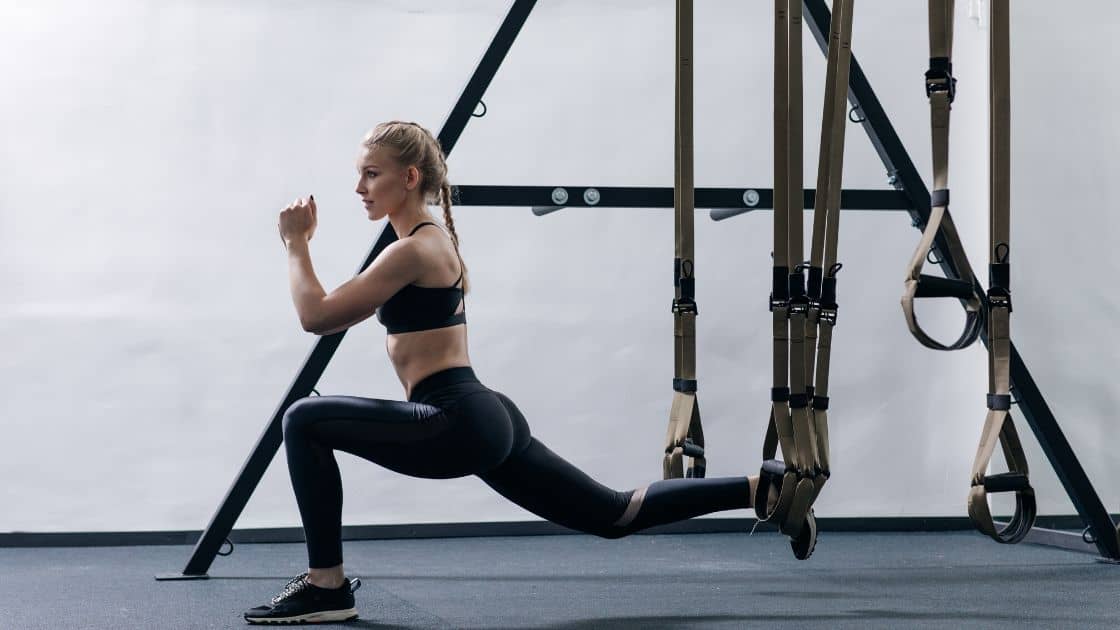
Reverse Fly
The reverse fly is a good exercise for the upper back. If you work a lot in front of the PC in a bent posture, then this TRX exercise is very helpful.
Starting position: Start in the same starting position as when pulling the row. Stand a little more vertical, however, as this exercise involves somewhat smaller muscle groups and requires less resistance.
Execution: Now open your arms wide to the side (like when a bird spreads its wings) and always keep your arms just below shoulder height. The movement is controlled by bringing the shoulder blades together. Then slowly let yourself back again.
Variation: The more horizontal your body line is, the more difficult the exercise will be. YOU can still vary the arm / upper body angle.
Trained muscle groups: Upper back, rear shoulder muscles
Mountain Climber
The mountain climber is a popular exercise for the abdominal muscles and is suitable for advanced climbers.
Starting position: Get into a push-up position with your feet in the leg loops. Build firm body tension. The feet should be hung about 5 to 10 cm above the floor.
Execution: Now alternately bring one knee forward towards the chest. Keep maximum tension in the abdomen and buttocks of the extended leg.
Variation: Increase the speed of the exercise or pull both legs towards your body at the same time.
Trained muscle groups: Abdominal muscles
Leg Curl
The leg curl is very well suited to train the rear leg muscles. This is not used enough in most leg exercises, as the leg extension is often trained.
Starting position: Lie on your back and place both feet in the leg loops. They should hang about 5 to 10 cm above the floor. Your body should be straight and your buttocks lifted.
Execution: Now bend your legs in the knee joint and lift off your buttocks. Then slowly stretch your legs again.
Variation: Do the exercise with one leg.
Trained muscle groups: Rear thigh muscles, glutes
Biceps Curl
Smaller muscle groups can also be strengthened with TRX exercises. Bicep curls are very easy to perform on the TRX.
Starting position: Start in the same starting position as when pulling the row. Make sure that the back of the hand points downwards when you grip.
Execution: Now slowly bend your arms at the elbow joint and bring your hands and shoulders together as much as possible. Then slowly stretch it back to the starting position.
Variation: Get more horizontal to make the exercise more difficult.
Trained muscle groups: Arm flexors and forearm muscles
Triceps Push
The triceps (arm extension) can also be easily trained as a TRX exercise.
Starting position: Start in the same starting position as for the push-up and keep your hands close together with the backs of the hands up.
Execution: Now reduce the angle in your elbows and bring your hands towards the shoulder. The elbows point downwards. Now stretch your arms back to the starting position.
Variation: Vary your posture to make the exercise more difficult.
Trained muscle groups: Arm extensors
TRX exercises – a training plan
Would you like to combine these TRX exercises in an effective training plan? You will find two variations for building muscle and strengthening your strength endurance. Beginners should start with strength endurance.
The TRX exercises are the same for both training plans. All you have to do is vary the number of sets, intensity and exercise time.
- Strength endurance: 2 sets are sufficient for endurance training. The duration of the exercise should be between 60 and 90 seconds. The number of repetitions is given as an example. The break time is 60 to 90 seconds.
- Muscle building: The hypertrophy training should be a little more intense and lead to the strain (fatigue) of the muscles. Do 3 to 4 sets per exercise. The duration should be between 40 and 60 seconds. The pause time is 120 to 150 seconds.
Implementation : You can do each exercise separately and then move on to the next exercise. If you want to increase the cardiovascular load or want to save time, do it as circuit training. You do one set of TRX exercise A and go straight to exercise B. After each circle you take a 2 to 4 minute break.
The following exercises are designed to work all muscle groups:
Warming up: Start with a few simple agility exercises. You can find it here: Improve mobility.
Activation: 2 x 20 seconds plank with full tension and concentration
Exercise order:
1) TRX rowing train
2) TRX squat (one-legged or two-legged)
3) TRX push-ups
4) TRX Reverse Fly
5) TRX Leg Curl
6) TRX biceps / triceps in quick alternation
Cool Down: To cool down you should relax a little. Breathing exercises or a little meditation (see learning meditation) are suitable.
Conclusion – TRX exercises
So that’s it: You now know the most effective TRX exercises and can now steel your muscles. We are convinced that no home gym can do without the TRX or the sling trainer.
But we have another insider tip for comprehensive training at home. How about adding a kettlebell to your equipment? This will raise the effectiveness of your training to a new level.
Take a look right here: Everything you need to know about kettlebells (ball dumbbells)!

